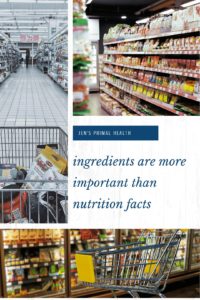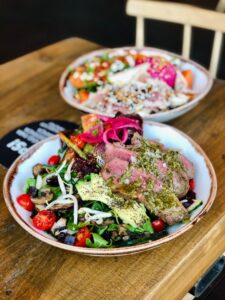I earn a small commission via affilate links at no extra cost to you.
For decades we’ve been told to check read the nutrition facts label if we want to eat and be healthy. The problem I see is that people check nutrition facts and ignore the ingredient list. Something may have the right amount of fat, carbohydrates, protein, and vitamins & minerals you’re looking for but is that enough? If you’re really looking for healthy food you have to learn how to read and understand the ingredient list. Unfortunately, the nutrition facts label simply doesn’t include enough information to let you know if you’re buying healthy food.
How Much Do You Absorb?
Many people today are increasingly becoming aware of gut health issues. Take gluten for example. If you’re sensitive to gluten (or really any ingredient) and it creates inflammation in your small intestine it can hinder nutrient absorption. Ninety percent of nutrient absorption occurs in the small intestine. Imagine what happens when your skin is inflamed. It’s red and swollen. In the intestine that swelling closes off the pores that allow nutrient absorption. Eating something doesn’t always guarantee that your body is actually going to receive that nutrient.
A great example of this is the phytates that are found in grains and legumes. How many people do you know that are deficient in Iron, Zinc, Manganese, Selenium, and Magnesium? I find that these minerals are highly sought after in supplements because people are missing them, or think they are missing them for whatever reason. (Hopefully, someone has tested your blood to be sure.) The other thing that’s interesting about phytates is that they bind to dietary protein. People who rely on legumes (beans, peas, and peanuts) for protein aren’t getting 100% of what these plant foods contain. These are things to be mindful of. The nutrition facts label may say that a product contains protein but you may not be absorbing it. This is one of the many reasons why you need to read the ingredient list. Many packaged foods contain ingredients made from corn, a grain, which means phytates could be present.
STUDY:
The presence of high levels of dietary trypsin inhibitors from soyabeans, kidney beans or other grain legumes have been reported to cause substantial reductions in protein and amino acid digestibility (up to 50 %) and protein quality (up to 100 %) in rats and/or pigs. Similarly, the presence of high levels of tannins in sorghum and other cereals, fababean and other grain legumes can cause significant reductions (up to 23 %) in protein and amino acid digestibility in rats, poultry, and pigs. Normally encountered levels of phytates in cereals and legumes can reduce protein and amino acid digestibility by up to 10 %. D-amino acids and LAL formed during alkaline/heat treatment of lactalbumin, casein, soya protein or wheat protein are poorly digestible (less than 40 %), and their presence can reduce protein digestibility by up to 28 % in rats and pigs, and can cause a drastic reduction (100 %) in protein quality, as measured by rat growth methods. [1]
Where Does The Protein Come From?
Studies have shown that protein is critical for human health. All protein is not the same. In the latest plant-based push in the media, many equate healthy food to plant-based protein. A lot of products have begun using pea protein to amp up the protein content of various foods. Sometimes the protein listed on a food package is associated with grains or legumes in that product. Plant-based protein is not a complete protein, that is it doesn’t contain all of the amino acids necessary to support the human body. Like I said previously, just because the ingredient list says it contains protein, it doesn’t mean it’s absorbed, or a complete protein.
Hopefully, the product you’re looking at has animal protein. Animal protein is a complete protein and it doesn’t contain any anti-nutrient phytates or gut damaging lectins if it’s pasture raised. (Read: 12 Reasons To Go Grain-Free)
What about protein shakes? Ugh…I despise protein shakes and smoothies for a number of reasons. The top reason is that digestion begins with chewing. When you’re drinking protein you’re missing the pre-digestion step. Then there is the ingredient list. Even protein shakes that are touted as healthy food due to their bare-bones ingredient list still contain gums and sweeteners. Insulin is a storage hormone that is released the moment something sweet touches your tongue. It doesn’t matter if it’s stevia, monk fruit, or erythritol, it’s still going to produce an insulin response. Furthermore, chewing sends a message to the brain that you’ve eaten. When you’re not chewing your brain isn’t getting the signal so it’s not going to fill you up as a real meal would.

If you want protein, eat meat, eggs, or fish. These are complete proteins that are nutrient-dense. They don’t contain any of the anti-nutrients and all of the nutrients translate without some funky biochemistry. At the basic level, you’re a red meat (on the inside) human so your body easily absorbs nutrients from red meat. Ya know?
Is It Healthy Fat?
Maybe the fat content on the nutrition facts label fits your lifestyle but where does that fat come from? The majority of fat calories in America come from industrial seed oils. Corn, Soy, Canola, Sunflower, Cottonseed, and Safflower oil are all highly processed and full of inflammatory Omega 6 fats. Storing them in clear containers under light further degrades these oils. (Good thing they keep them on the top shelf at the grocery store…) While the body does need Omega 6 fats the ideal ratio of Omega 3 to Omega 6 should be 1:1 or 1:2. In America, the ratio is typically as high as 1:25.
What’s wrong with vegetable oil besides creating inflammation? The body absorbs these fats into your cell membranes and mitochondrial membranes. In fat cells, they hinder fat loss and in your mitochondria, they reduce the amount of energy (ATP) your cells can make. Adenosine TriPhosphate (ATP) is used any time the body needs energy to perform a function. For example, allowing nutrients into a cell sometimes requires ATP, depending on the nutrient of course. Vegetable oils damage DNA, cause cancer and have been linked to macular degeneration among other chronic health conditions. This is one of the many reasons to read the ingredient list if you’re focused on eating healthy food. The nutrition facts don’t tell the whole story.
Polyunsaturated fatty acids (found in vegetable oils) have highly perishable bonds that react with oxygen, creating a free radical cascade that turns normal fatty acids in your body into dangerous high-energy molecules that zip around, wreaking havoc in a way similar to that of radiation. [2]
Conclusions Advice to substitute polyunsaturated fats for saturated fats is a key component of worldwide dietary guidelines for coronary heart disease risk reduction. However, clinical benefits of the most abundant polyunsaturated fatty acid, omega 6 linoleic acid, have not been established. In this cohort, substituting dietary linoleic acid in place of saturated fats increased the rates of death from all causes, coronary heart disease, and cardiovascular disease. An updated meta-analysis of linoleic acid intervention trials showed no evidence of cardiovascular benefit. These findings could have important implications for worldwide dietary advice to substitute omega 6 linoleic acid, or polyunsaturated fats in general, for saturated fats. [3]
Additives As Food Ingredients
When you’re only looking at the nutrition facts label you’re not looking at the long list of ingredients. Odds are, if you read the ingredients on nearly box, bag, jar, or can of food you’ll find additives of one form or another. Humans who want to improve their health with healthy food don’t need the mountain of additives found in a traditional supermarket.
My clean eating journey began when I worked as an analytical chemist. I’d see chemical safety sheets at work and then see the same chemicals in the grocery store. While I understand that too much of anything usually isn’t good, even if it’s only table salt or water, there is an instinct you have when you encounter some chemicals. BHT (butylated hydroxytoluene) is one of those that I will never forget. I began to see those LD50’s on the MSDS sheets a bit differently.
(LD50 is the dose that will kill 50% of mice.)
If “X” amount will kill 50% of mice how does that affect humans on the molecular and cellular level? Sure, they don’t put “X” amount in 1 box of food but what if you buy that same box of food each time you go to the store? What happens when you have a bit of chemical X, Y, or Z over the course of years? Decades? No one knows. Now take all of those chemicals and put them together in various combinations and eat them regularly.
It’s a science experiment that needs to be done but the logistics are improbable. Nor would too many people be a willing participant if you asked them to join this study. However, this is what our “food” system has become.
For many processed foods they add “vitamins & minerals” to make them appealing to consumers. Um…if you have to add vitamins & minerals to make something nutritious why are we calling it food, let alone healthy food, in the first place? This is another instance where the nutrition facts can be misleading. A product may contain iron, for example, but that doesn’t necessarily mean that your body will absorb it. Skip the marketing terms on the front of the box and read the ingredient list. If you don’t know what an ingredient is, use your smartphone to look it up.
Do you know what really grinds my gears? Our food companies currently make cleaner versions of their products for European countries because their governments demand it.
“Healthy” Whole Grains
Whether you read Wheat Belly, Grain Brain, The Story Of The Human Body, Eat Fat Get Thin, Good Calories Bad Calories, Primal Fat Burner, Deep Nutrition, and several others… You’ll see that grains aren’t healthy and whole grains are even worse. Conventional wisdom says that whole grains contain more nutrients so it’s believed that they’re healthy food ingredients. However, whole grains also contain more anti-nutrient phytates and gut-damaging lectins than refined grains do. Refined grains are stripped of these anti-nutrients but they also don’t contain much nutrition. The end result is that it’s just bulk food that offers very little nutrition if any at all. Then there is the insulin spike (because a carbohydrate is a carbohydrate), which creates arterial inflammation along with inflammation throughout the body, and gut health damage…to name a few. Read my 12 reasons to go grain-free here.
Don’t Rely On The Nutrition Facts Label, Read The Ingredients
Read the ingredients and learn what they are. There is an astounding number of ingredients that are derived from GMO corn. Vitamin E and C are two prime examples of possible GMO ingredients that unsuspecting people are not aware of. Know what you’re putting in your body and what the consequences of those choices are. Even some pre-packaged paleo foods aren’t always the best choice. There are many that say paleo-friendly but still contain one of the vegetable oils I mentioned above. Maybe the ingredients are paleo but the amount of sugar puts it on par with a candy bar. The first step to take charge of your health and fitness is to pay attention to what you consume. Food choice contributes to 80% of nearly any health goal you have for yourself.
[1] Sarwar Gilani G1, Wu Xiao C, Cockell KA. Impact of antinutritional factors in food proteins on the digestibility of protein and the bioavailability of amino acids and on protein quality. Br J Nutr. 2012 Aug;108 Suppl 2:S315-32. doi: 10.1017/S0007114512002371. https://www.ncbi.nlm.nih.gov/pubmed/23107545
[2] Dietary Fats — The Good, the Bad and the Ugly, https://articles.mercola.com/sites/articles/archive/2017/06/25/good-bad-ugly-dietary-fats.aspx
[3] Use of dietary linoleic acid for secondary prevention of coronary heart disease and death: evaluation of recovered data from the Sydney Diet Heart Study and updated meta-analysis, BMJ 2013;346:e8707, https://www.bmj.com/content/346/bmj.e8707
Originally posted on February 14, 2020 @ 10:48





